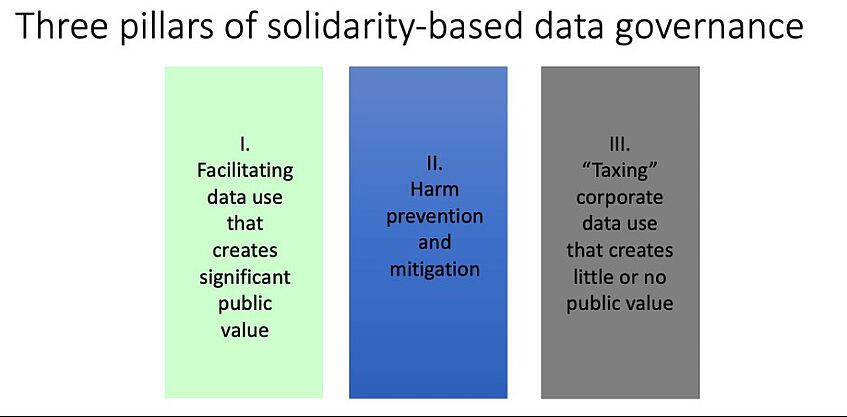What is Data Solidarity – and how is it different from data altruism?

Illustration 1: Three pillars of Data Solidarity
What is Data Solidarity – and how is it different from data altruism?
Barbara Prainsack
1. What is Data Solidarity?
Solidarity-based data governance (Data Solidarity) is a new approach to digital data governance. It seeks to distribute the benefits and the risks of digital practices more fairly. It does so by increasing collective control and oversight over data, in addition to individual control. Many problems of the digital age cannot be addressed merely by giving individuals more control over their data, including the growing power asymmetries between data subjects and organisations using data, the loss of democratic control over digital public spaces, or the fact that commercial profits from digital practices accrue mainly in the Global North.
Data Solidarity includes three core pillars: Pillar I is aimed at facilitating data use that is likely to create significant public value and does not pose unacceptable risks. Pillar II seeks to prevent harm, and where this is not possible, to mitigate it – because existing legal remedies are insufficient. Pillar III aims to ensure that an increasing share of profits that emerge from commercial data use are returned to the public domain.
The three pillars of solidarity-based data governance:
- Facilitating data use that creates significant public value
- Harm prevention and mitigation
- "Taxing" corporate data use that creates little or no public value
Data Solidarity proposes a set of measures for each of the three pillars (for details, see the Data Solidarity White Paper). Another key component of Data Solidarity is to ensure that regulatory frameworks treat data uses that are likely to create significant public value differently from data uses that do not (in this short paper we explain how this can be done). To enable the measurement of such public value, the Data Solidarity team is currently developing an online tool for the structured assessment of the public value of data use (PLUTO).The tool will be publicly available in October 2023.
2. How is Data Solidarity different from Data Altruism?
Data Solidarity differs considerable from data altruism. Data altruism is a concept used by the EU Data Governance Act (DGA), for example, where it refers to the voluntary sharing of data by individuals or organisations for purposes that are in the public interest. Under the DGA, ‘data altruism organisations’ (which need to be accredited as such) can collect altruistically shared data directly from data subjects and make them available for other data users.
While both data altruism and Data Solidarity have some goals in common – e.g. they both try to making it easier to use data for purposes that benefit the public – there are important differences. First, data altruism implies that data subjects give up their rights when they make their data available for altruistic use. Data Solidarity, in contrast, ensures that people always retain a say in how data is used, either directly (via individual consent) or indirectly (via collective governance modes). Second, while the stated goal of data altruism under the DGA is to ‘support the economic growth and competitiveness of the EU,’ Data Solidarity’s aim is to ensure a fairer distribution of burdens and benefits emerging from digital practices, and to better protect people and communities from data harms. Third, while both data altruism and Data Solidarity seek to make it easier for data to be used for public benefit, Data Solidarity rejects data altruism’s binary assessment of whether data use is in the public interest or not. This is also because powerful companies are likely to be able to ‘prove’ that anything they do is in the public interest, while smaller businesses or non-profits regularly cannot. This would create a Matthew effect – meaning that those corporations that are already powerful will be able to increase their access to data even further. Instead, Data Solidarity promotes are more nuanced assessment of the public value of data use that weighs benefits v. risks for individuals and communities (and that will also be open to public scrutiny). Fourth and last, Data Solidarity does not only emphasise the altruistic duty of data sharing but also actively protects the rights and interests of data subjects.
| Data altruism | Data Solidarity |
Rights and interests of data subjects | People give up their rights when they agree to altruistic data use | People retain rights and interests in data while at the same time deciding (individually or collectively) what data is used for |
Key goals | Increase the EU’s economic competitiveness and support economic growth
| A fairer distribution of risks and benefits stemming from digital practices, and better protection of people from data harms |
Criteria for making data use easier | If data use is considered in the public interest | If data use is likely to benefit people, communities, or societies as a whole, without posing high risks to anyone (i.e. high public value) |
Balance between rights and duties | Highlighting the duty of data sharing | Emphasising the protection of rights and interests of people and communities, from which some data uses naturally emerge as beneficial |
Table 1: Differences between data altruism and Data Solidarity
Barbara Prainsack, Seliem El-Sayed, Connor Hogan, and Nikolaus Forgó, Research Platform Governance of Digital Practices, University of Vienna, Austria. Contact: Barbara.prainsack@univie.ac.at; Twitter: @bprainsack.
